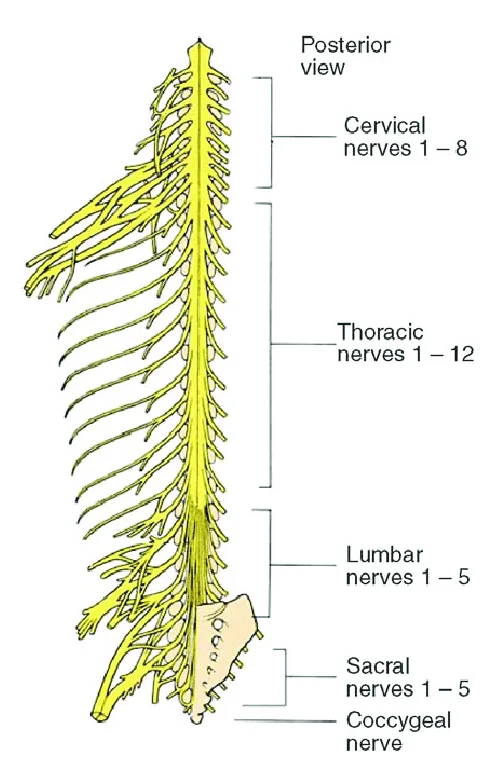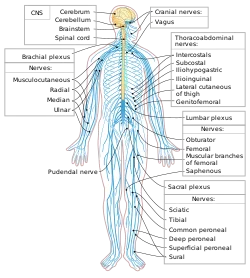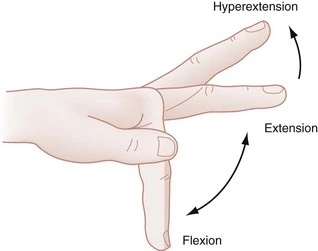How Many Nerves Are in The Human Body?
Table of Contents
What are nerves?

- More than 100 billion nerve cells (neurons) make up the peripheral nervous system, which runs like strings throughout the body and connects to the brain, other body regions, and frequently other nerve cells.
- Bundles of nerve fibers make up peripheral nerves. These fibers are covered in numerous layers of tissue made of myelin, a fatty material. The myelin sheath, which is formed by these layers, quickens the conduction of nerve impulses along the nerve fiber. In accordance with their dimensions and the amount of myelin surrounding them, nerves conduct impulses at various speeds.
- Two segments make up the peripheral nervous system:
- somatosensory nervous system
- system of the autonomic nervous
- body’s own nerve system
- This system is made up of nerves that link the brain, spinal cord, and muscles under conscious control (skeletal or voluntary muscles), as well as sensory receptors in the skin. Sensory receptors are specialized nerve fiber ends that pick up information about the body and its surroundings.
Nervous system autonomic
- This system regulates internal bodily functions that don’t involve conscious effort and that people are typically unaware of by connecting the brain stem and spinal cord with internal organs (see Overview of the Autonomic Nervous System). Examples include the heartbeat’s frequency and force, blood pressure, breathing rate, and how quickly food moves through the digestive system.
- There are two areas of the autonomic nervous system:
- The sympathetic division’s primary job is to get the body ready to either fight or flee in stressful or emergency situations.
- The primary purpose of the parasympathetic division is to keep the body functioning normally in everyday circumstances.
- Together, these divisions often function to activate and inhibit the actions of internal organs. For instance, the parasympathetic system slows each of these processes down whereas the sympathetic division speeds them up.
- The direct network of contact in your body is your nervous system. It regulates and maintains the numerous bodily processes along with your endocrine system. It also facilitates interaction with a person’s environment.
- A network of nerves and nerve cells make up your nervous system, which is responsible for sending and receiving signals between your brain, spinal cord, and the rest of your body.
- A nerve is a group of fibers that relays communication between the brain and the body. The neurons, which are the cells that make up the nerves, change chemically and electrically to transmit the messages.
In your body, how many of these nerves are there?
- From the top of our heads to the tips of our toes, humans are believed to have hundreds of nerves and billions of neurons, while the exact number is unknown.
- Continue reading to discover more about your nervous system’s fascinating facts, the numbered and named cranial and spinal nerves, and the chemical makeup of neurons.
Nerves in the body
- the way the nervous system is organized
- Your nervous system is separated into two groups:
- The central nervous system (CNS), which is composed of your brain and spinal cord, serves as the body’s control center. Your skull shields your brain, while your vertebrae guard your spinal cord.
- Peripheral nervous system (PNS): Nerves that emerge from your central nervous system (CNS) make up the PNS. Axon bundles called nerves are used by the body to carry signals.
- It is possible to further divide the PNS into sensory and motor sections:
- Your sensory system sends data to your central nervous system (CNS) from both within and outside your body. This can include unpleasant sensations, odors, and visual images.
- The CNS sends messages to the motor division, which then triggers an action. Moving your arm is an example of voluntary action, whereas the muscle contractions that help move food through your digestive tract are examples of involuntary action.
Cranial nerves
- The PNS includes the cranial nerves. The 12 pairs of cranial nerves in your head.
- The cranial nerves can perform sensory, motor, or both types of tasks. For instance:
- A sensory function is served by the olfactory nerve. The brain receives information about the smell from it.
- There is a motor function for the oculomotor nerve. It regulates how your eyes move.
- The face nerve includes both motor and sensory capabilities. It also regulates the movement of several of the muscles in your face. It conveys taste sensations from your tongue.
- Your head, face, and neck are served by cranial nerves that leave the brain. The vagus nerve, the longest-trusted Source cranial nerve, is an exception to this rule.
Spinal nerves
- Your PNS also includes the nerves in your spine. They diverge from the spinal cord. In the Human Body, there are 31 pairs of spinal nerves. They are organized according to the region of the spine with which they are connected.
- Sense and movement are both carried out by spinal nerves. This means that they have the capacity to both transfer commands from the CNS to the peripheral parts of your body and to send sensory data to the CNS.
- Dermatomes are also connected to spinal nerves. A particular patch of skin called a dermatome is supplied by a single spinal nerve. Your spinal nerves, with the exception of one, send sensory data from this region to the CNS.
How many nerves are there overall then?
- Your body contains several hundred peripheral nerves. The sensory branches of the cranial and spinal nerves are formed when the numerous sensory nerves that transmit sensation from the skin and internal organs combine.
- The spinal nerves and cranial nerves’ motor segments split into smaller nerves, which then split into still smaller nerves. So, anywhere between 2 and 30 peripheral nerves can branch out of a spinal or cranial nerve.
How is a nerve cell constructed?
- The neurons in your body function to carry nerve signals. They consist of three parts:
- Similar to other cells in your body, the cell body houses a variety of cellular parts, such as the nucleus.
- Dendrites: Extending from the cell body are dendrites. Other neurons send signals to them. A neuron may have one or several dendrites.
- Axon: The axon extends from the cell body as well. It is normally longer than the dendrites. Myelin, which helps to protect and insulate the axon, is frequently found covering axons.
- Approximately 100 billion neurons are found in your brain alone (but one study claims the number is closer to 86 billion)
How do nerves function?
- So how precisely do neurons function? Let’s examine a particular form of neuronal signaling below:
- An electrical impulse is sent down the length of the axon when one neuron signals another.
- The electrical signal is changed into a chemical signal at the axon’s end. As a result, substances referred to as neurotransmitters are released.
- The neurotransmitters fill the synapse, which is the space between the next neuron’s axon and dendrites.
- The chemical signal is again transformed into an electrical signal and travels the length of the neuron when the neurotransmitters link to the dendrites of the following neuron.
- Axon bundles that makeup nerves cooperate to promote communication between the CNS and PNS. It’s crucial.
- A neurological illness can happen when nerves are harmed or aren’t signaling appropriately. Neurological illnesses come in a wide range and are caused by numerous different factors.
- Multiple sclerosis and epilepsy
- Parkinson’s condition
- Alzheimer’s condition
Is length important?
- The axon of a neuron can differ in length. Some may only be a few millimeters long, while others may reach one meter.
- Similar to this, nerves come in a variety of sizes. Your nerves typically get smaller as your PNS divides.
- The biggest nerve in your body is the sciatic nerve. It starts in your lower back and extends all the way to your foot’s heel.
- You may have heard of sciatica, a condition in which your lower back and leg experience radiating pain. When the sciatic nerve is pinched or inflamed, this occurs.
How are the nerves organized?
- In the nerves, there are:
- Axons are cord-like groups of fibers found in the nerve’s core.
- Branch-like structures called dendrites carry electrical impulses.
- Axons are surrounded by a coating of connective tissue named the endoneurium.
- The fascicles of axons are enveloped by a layer of connective tissue known as the perineurium.
- The outer layer of the nerve is protected by a layer of connective tissue called the epineurium.
What diseases and disorders affect the nervous system?
- The nerves’ ability to transmit messages is impacted by certain circumstances. You could develop a neurological disorder if damage or any type of harm prevents nerve signals from traveling properly.
- the following are typical nerve disorders:
- Damage to the peripheral nerves (nerves away from the brain and spinal cord) is referred to as peripheral neuropathy.
- Sciatica is a type of back pain that affects the sciatic nerve, which travels from the lower back down the backs of both legs.
Location
classification of the Areas of the Sensory Roots upon the Texture of the Body
- anatomy of the nervous system
- Development of the nervous system
- The spinal cord & medulla spinalis
- The brain & encephalon
- The hindbrain or rhombencephalon
- The midbrain or mesencephalon
- The forebrain or prosencephalon
- Composition & central association of the spinal nerves
- the route from the brain to the spinal cord
- The meninges or outer body of the brain & medulla spinalis
- The cerebrospinal fluid
List of Cranial nerves

The cranial nerves-there are a total of 12 duos of cranial nerve
- The olfactory nerve
- The optic nerve
- The oculomotor nerve
- The trochlear nerve
- The trigeminal nerve
- The abducens nerve
- The facial nerve
- The vestibulocochlear nerve
- The glossopharyngeal nerve
- The vagus nerve
- The accessory nerve
- The hypoglossal nerve
List of The spinal nerves

spinal nerves are mixed types of nerves that interact instantly with the spinal cord to modulate motor & sensory information from the body periphery.
- The posterior divisions
- The anterior divisions
- The thoracic nerves
- The lumbosacral plexus
- The sacral and coccygeal nerves
- The sympathetic nerves
- The cephalic portion of the sympathetic system
- The cervical portion of the sympathetic system
- The thoracic portion of the sympathetic system
- The abdominal portion of the sympathetic system
- The pelvic portion of the sympathetic system
- The great plexuses of the sympathetic system
Index of Nerves of the upper limb
- Brachial plexus
- Axillary nerve
- Dorsal scapular nerve
- Dorsal branch of the ulnar nerve
- Musculocutaneous nerve
- Radial nerve
- dorsal scapular nerve
- thoracic nerve
- suprascapular nerve
- nerve to subclavius
- lateral pectoral nerve
- medial pectoral nerve
- the medial cutaneous nerve of the arm
- the medial cutaneous nerve of the forearm
Index of the Nerves in the lower limb
- branches of lumbar plexus (L1-S4)
- iliohypogastric
- ilioinguinal
- genitofemoral
- lateral femoral cutaneous
- obturator nerve
- femoral nerves.
- branches of sacral plexus (L5-S2);
- superior gluteal
- inferior gluteal
- sciatic nerve
- posterior femoral cutaneous,
- pudendal nerves
- nerve to piriformis
- nerve to obturator internus
- nerve to quadratus femoris.
- saphenous nerve
- femoral cutaneous nerves
- obturator nerve
- gluteal nerve
- cluneal nerve
- superior genicular (medial &lateral)
- inferior genicular (medial &lateral)
- middle genicular
- tibial nerve
- deep fibular nerve
- dorsal digital nerves
- proper plantar digital nerves
- lateral dorsal cutaneous nerve
- plantar nerves
sympathetic nerve-The sympathetic system controls “fight-or-flight” responses.
Nerve supply to the heart
- cardiac plexus
- vagus nerves
- vagal cardiac nerves
Nerve supply to the thoracic region
- intercostal nerve
Nerve supply to the lung
- pulmonary plexus
- vagus nerve [parasympathetic innervation-]
Nerve supply to the liver
- hepatic plexus
- coeliac plexus [sympathetic supply]
- vagus nerve [parasympathetic innervation-]
Nerve supply to the small intestine
- splanchnic vagus nerve [parasympathetic innervation]
Nerve supply to the large intestine
- vagus nerve [parasympathetic innervation-]
- pelvic splanchnic nerves.
- The superior & inferior mesenteric
- inferior hypogastric plexus
FAQs
Which three types of nerves are there?
The three types of nerves in the human body are separated based on their functions:
sensory nerves.
muscle nerves.
mixed nerves.How do nerves influence the eyes?
The motor, sensory, and autonomic structures in the eyes are innervated by six cranial nerves. The optic nerve, the oculomotor nerve, the trochlear nerve, the trigeminal nerve, the abducens nerve, and the facial nerve are the six cranial nerves.
What body parts makeup nerves?
The brain and spinal cord, which are arranged in the dorsal body cavity, are encased in bone for safeguarding since they are so crucially important. The spinal cord lies in the vertebral canal of the vertebral column, while the brainiac is in the cranial locker.
Why do nerves hurt?
A specific kind of pain called “nerve pain” (neuralgia) frequently has a shooting, stabbing, or burning feeling. It is brought on by harm or injury to the brain or to the nerves that communicate pain to your brain. It might be challenging to cure nerve discomfort.
Are nerves blood vessels?
The network of the nerves, which is equally astonishing, can both transport and “store” blood for the nerves. How incredible are networks? Major blood systems are always near to nerves. If you locate a nerve, a large artery will be nearby and ready to supply it with blood.





